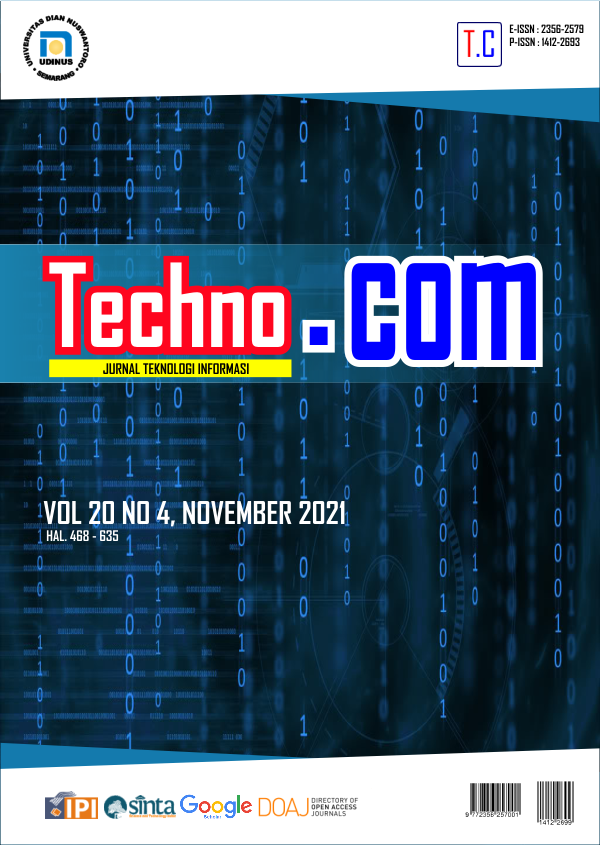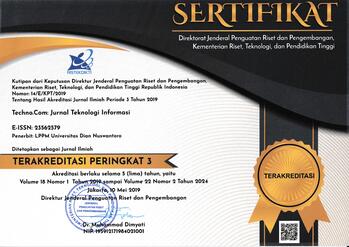Pengukuran Tingkat Kesiapan E-learning Guru di Kota Jayapura di Masa Pandemik Covid-19
DOI:
https://doi.org/10.33633/tc.v20i4.5168Keywords:
e-learning readiness, teacher, JayapuraAbstract
E-learning is one of the revolutions in the education system that encourages the acceleration of quality learning. The Covid-19 pandemic has become a catalyst for accelerating the implementation of e-learning in Jayapura, Papua. Teachers are required to be able to adapt to this rapid change. Thus, E-learning becomes essential amid the pandemic, yet the ICT indicators reveal many barriers to implementing it. This study aims to assess the level of readiness of the teachers in implementing the e-learning system. Data was collected by distributing questionnaires to the teachers from elementary to high school in Jayapura City. Technology infrastructures, human resources, and e-learning content were the main variables to measure. This study indicated that based on teachers' perceptions, more than 70 percent were using google classroom as an e-learning platform. The level of readiness was level 3 (ready with minor improvements). Infrastructures, internet access, and e-learning content availability are the indicators that needed extra attention for improvementReferences
K. Basak, S. Wotto, M. Bélanger, and Paul, “E-learning, M-learning and D-learning: Conceptual definition and comparative analysis,” E-learning Digit. Media, vol. 15, no. 4, pp. 191–216, 2018, doi: 10.1177/2042753018785180.
R. J. Ventayen, “Teachers’ Readiness in Online Teaching Environment: A Case of Department of Education Teachers,” J. Educ. Manag. Soc. Sci., vol. 2, no. 1, 2018, [Online]. Available: www.psurj.org/jemss.
R. Scherer, S. K. Howard, J. Tondeur, and F. Siddiq, “Profiling teachers’ readiness for online teaching and learning in higher education: Who’s ready?,” Comput. Human Behav., vol. 118, no. January 2021, p. 106675, 2021, doi: 10.1016/j.chb.2020.106675.
D. C. Brooks and S. Grajek, “Faculty Readiness to Begin Fully Remote Teaching,” 2020. https://er.educause.edu/blogs/2020/3/faculty-readiness-to-begin-fully-remote-teaching (accessed Aug. 20, 2021).
Kementerian Pendidikan dan Kebudayaan, Kepmendikbud Nomor 719/P/2020 tentang Pedoman Pelaksanaan Kurikulum pada Satuan Pendidikan dalam Kondisi Khusus. 2020, p. 9.
Kementerian Pendidikan dan Kebudayaan, “Penyesuaian Kebijakan Pembelajaran di Masa Pandemi COVID-19,” 2020. [Online]. Available: https://www.kemdikbud.go.id/main/blog/2020/08/kemendikbud-terbitkan-kurikulum-darurat-pada-satuan-pendidikan-dalam-kondisi-khusus.
T. Andarwulan, T. A. Al Fajri, and G. Damayanti, “Elementary teachers’ readiness toward the online learning policy in the new normal era during Covid-19,” Int. J. Instr., vol. 14, no. 3, pp. 771–786, 2021, doi: 10.29333/iji.2021.14345a.
S. R. Febriani, R. Widayanti, M. A. Amrulloh, and N. Mufidah, “Arabic Learning for Elementary School during COVID-19 Emergency in Indonesia,” OKARA J. Bhs. dan Sastra, vol. 14, no. 1, p. 67, 2020, doi: 10.19105/ojbs.v14i1.3194.
V. Arkorful and N. Abaidoo, “The role of e-learning, advantages and disadvantages of its adoption in higher education,” Int. J. Instr. Technol. Distance Learn., vol. 12, no. 1, pp. 29–42, 2015.
D. Napitupulu, K. Adiyarta, D. Abdullah, and D. Murtiningsih, “Proposed ELR Model for E-learning Readiness Evaluation Based on McKensey 7S Framework,” no. 6, 2019, doi: 10.4108/eai.18-7-2019.2288544.
K. Adiyarta, D. Napitupulu, R. Rahim, D. Abdullah, and M. I. Setiawan, “Analysis of e-learning implementation readiness based on integrated elr model,” J. Phys. Conf. Ser., vol. 1007, no. 1, 2018, doi: 10.1088/1742-6596/1007/1/012041.
A. Saekow and D. Samson, “E-learning Readiness of Thailand’s Universities Comparing to the USA’s Cases,” Int. J. e-Education, e-Business, e-Management e-learning, vol. 1, no. 2, 2011, doi: 10.7763/ijeeee.2011.v1.20.
Samantha Chapnick, “Are You Ready for E-learning?,” 2000. https://nurhadiw.files.wordpress.com/2010/08/are_you_ready_for_e-learning.pdf.
C. H. Aydin and D. Tasci, “Measuring readiness for e-learning: Reflections from an emerging country,” Educ. Technol. Soc., vol. 8, no. 4, pp. 244–257, 2005.
C. T. Lopes, “Evaluating e-learning readiness in a health sciences higher education institution,” Proc. IADIS Int. Conf. e-learning, EL 2007 - Part IADIS Multi Conf. Comput. Sci. Inf. Syst. MCCSIS 2007, vol. 1, no. July, pp. 59–67, 2007.
K. Kaur and Z. W. Abas, “An assessment of e-learning readiness at Open University Malaysia.,” in International Conference on Computers in Education., 2004, vol. 88, no. 2, pp. 231–233, doi: 10.1016/0014-5793(78)80181-1.
M. Mailany, “Analisis Faktor-Faktor Pengukuran Tingkat Kesiapan Implementasi E-learning di Perguruan Tinggi,” 2015.
D. Napitupulu, “Kesiapan Implementasi Sistem e-learning di Lingkungan Universitas XYZ,” in Seminar Nasional Technopreneurship dan Alih Teknologi, 2016, no. October 2016.
APJII, “Penetrasi & Perilaku Pengguna Internet Indonesia Survey 2017,” Teknopreneur, vol. 2018, no. 31 August 2018, p. Hasil Survey, 2017.
Badan Pusat Statistik, Indeks Pembangunan Teknologi Informasi dan Komunikasi. 2019.
C. A. Mercado, “Readiness Assessment Tool for An e-learning Environment Implementation,” Fifth Int. Conf. e-learning Knowledge-Based Soc., no. 2005, pp. 1–11, 2008.
S. K. Sharma, S. Gulsecen, Z. Ozen, and E. Kartal, “Assessing E-learning Readiness of Instructors in Turkey Sushil,” vol. 1, no. 3, p. 24, 2015, [Online]. Available:
https://www.researchgate.net/publication/262808265_Assessing_E-learning_Readiness_of_Instructors_in_Turkey.
W. Sulistio, “Pengukuran Kesiapan Implementasi E-learning: Studi Kasus Pusdiklat XYZ,” Universitas Indonesia, 2013.
Downloads
Published
Issue
Section
License
Copyright (c) 2021 Remuz Maurenz Bertho Kmurawak, Samuel Alexander Mandowen

This work is licensed under a Creative Commons Attribution-NonCommercial 4.0 International License.
Pernyataan Lisensi
Artikel yang diterbitkan dalam jurnal Techno.Com dilisensikan di bawah Lisensi Creative Commons Atribusi-NonKomersial 4.0 Internasional (CC BY-NC 4.0).
Anda diperbolehkan untuk menyalin, mendistribusikan, menampilkan, dan melakukan karya dari artikel ini serta membuat karya turunan selama Anda memberikan kredit yang sesuai kepada penulis asli dan tidak menggunakan karya ini untuk tujuan komersial. Untuk melihat salinan lisensi ini, kunjungi [Creative Commons Attribution-NonCommercial 4.0 International](https://creativecommons.org/licenses/by-nc/4.0/).
---
Contoh pengkreditan:
- Penulis: [Nama Penulis]
- Judul Artikel: [Judul Artikel]
- Jurnal: Techno.Com, Vol. [Nomor Volume], No. [Nomor Edisi], Tahun [Tahun Penerbitan]
Jika Anda ingin menggunakan karya ini untuk tujuan komersial, Anda harus mendapatkan izin terlebih dahulu dari penulis atau penerbit.
---














